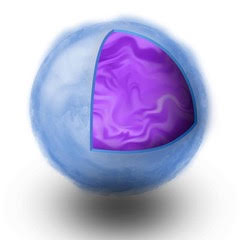Skip Navigation

Heavy nuclei have more neutrons than protons. Scientists have now measured the neutron skin depth (blue) surrounding the more evenly distributed core of protons and neutrons.
Search
Precise Measurement of Neutron Skin in the Lead Nucleus
Stony Brook/CFNS physicists (Deshpande and Kumar groups in the PREX Collaboration)
have made the most precise measurement of neutron skin in a nucleus which has deep
implications to the structure of neutron stars. The result published in PRL is being highlighted by the DOE Office of Science’s “Highlights of 2021” this month. Using the precision of the electro-weak force, PREX collaboration measured
the spin-dependent electron-Lead scattering and determined the neutron skin depth
in the lead nucleus to be (0.28 ± 0.07) femtometer. In state-of-the-art nuclear structure
models, this leads to a smaller density and higher internal pressure of the lead nucleus
which then has important implications for our knowledge of the neutron stars and also
what can be learnt from their mergers observed by the LIGO experiment (Nobel Prize
2017).
Stony Brook/CFNS research scientists in Deshpande/Kumar group played leading roles
on multiple fronts: Dr. Ciprian Gal was the Run-Coordinator and the Analysis-Coordinator
for PREX-2. Graduate students (GS) Cameron Clarke, Tyler Kutz, Ryan Richard, and Weibin
Zhang, led the main analyses. They and others including Catherine Feldman (GS), Chandan
Ghosh (post doc : PD), Mriganka Mondal (PD), Sanghwa Park (PD), Marissa Petrusky
(Undergraduate), and Jinlong Zhang (PD) contributed to important aspects of the preparation
and operation of the experiment.

Heavy nuclei have more neutrons than protons. Scientists have now measured the neutron skin depth (blue) surrounding the more evenly distributed core of protons and neutrons.
